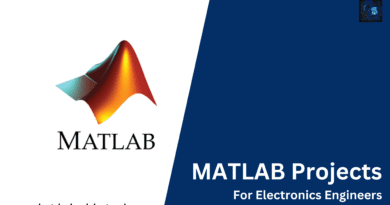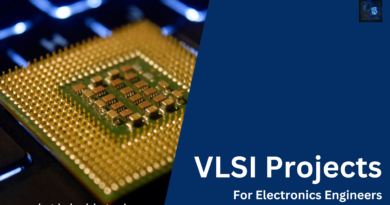Top 5 Programming Languages Used In The Semiconductor Industry
Hello guys, welcome back to our blog. Here in this article, we will discuss the top 5 programming languages used in the semiconductor industry, what is the purpose of these programming languages, and their benefits.
If you have any electrical, electronics, and computer science doubts, then ask questions. You can also catch me on Instagram – CS Electrical & Electronics.
Also, read:
- What Kinds Of Sensors Are Used In Autonomous Vehicles
- Optical Circuit Breakers, Future Of Circuit Breakers In Power Systems
- Brain Computer Interfaces Technology, Beyond AI, ML, IoT, Blockchain
Programming Languages Used In The Semiconductor Industry
C++: A Powerhouse in the Semiconductor Industry
C++ is not just a programming language; it’s a cornerstone of the semiconductor industry’s success. Renowned for its exceptional speed, efficiency, and flexibility, C++ has established itself as the go-to choice for developing a wide array of applications that power this ever-evolving industry.
One of the most critical applications of C++ in the semiconductor realm is in Electronic Design Automation (EDA) tools. These tools are instrumental in Integrated Circuit (IC) design and verification, enabling engineers to craft intricate and cutting-edge semiconductor designs with precision. C++ provides the robust foundation upon which these EDA tools are built, allowing for the creation of sophisticated software that can simulate, analyze, and validate complex chip designs.
However, the reach of C++ extends far beyond IC design alone. It plays a pivotal role in crafting software for semiconductor manufacturing equipment. In the heart of semiconductor fabrication facilities, C++-powered software controls and monitors the intricate processes that transform raw materials into sophisticated chips. The speed and efficiency of C++ are indispensable in ensuring that these manufacturing processes run seamlessly and produce high-quality semiconductors.
Furthermore, C++ finds its place in the firmware of embedded systems within semiconductors. These embedded systems are the unsung heroes that enhance the functionality and performance of semiconductor chips in various applications. C++’s ability to deliver efficient and reliable code is crucial in ensuring these embedded systems operate flawlessly, from powering consumer electronics to automotive applications.
Python: Simplicity and Versatility in Semiconductor Innovation
Python, with its reputation for simplicity, readability, and versatility, has been making significant inroads into the semiconductor industry. Its user-friendly syntax and vast ecosystem of libraries and frameworks have made it an increasingly popular choice for a multitude of semiconductor applications.
One area where Python shines brightly is in the realm of data science and machine learning. In semiconductor manufacturing, data is king. Python’s rich collection of data analysis and machine learning libraries empowers engineers to extract valuable insights from massive datasets. This, in turn, leads to better process control and yield improvement, enhancing the overall efficiency and quality of semiconductor production.
Automation is another arena where Python is a game-changer. The semiconductor industry is known for its complex and repetitive tasks, from design to manufacturing to testing. Python scripts and automation tools streamline these processes, reducing manual labor and minimizing the risk of errors. Engineers can focus on innovation while Python takes care of the routine tasks, resulting in faster development cycles and improved productivity.
Python’s versatility extends to the development of web applications and Graphical User Interfaces (GUIs) for semiconductor tools and equipment. Creating user-friendly interfaces that simplify complex semiconductor processes is made easier with Python’s extensive libraries and frameworks. Whether it’s designing a GUI for semiconductor testing equipment or a web application for remote monitoring of semiconductor production, Python’s simplicity makes it an excellent choice.
SystemVerilog: Ensuring Semiconductor Chip Integrity
In the intricate world of semiconductor design and verification, SystemVerilog emerges as a specialized hardware verification language. Built upon the foundation of the Verilog language, it introduces a host of advanced features tailored specifically for design verification.
One of the key strengths of SystemVerilog is its ability to verify the design of Application-Specific Integrated Circuits (ASICs) and other semiconductor chips. In the semiconductor industry, where precision is paramount, SystemVerilog is the trusted tool for confirming that complex chip designs meet the highest standards of functionality and integrity.
Concurrency modeling is one of the essential features that SystemVerilog brings to the table. In the realm of semiconductor chip design, multiple processes often run simultaneously. SystemVerilog provides a robust framework for modeling these concurrent processes, ensuring that they interact seamlessly and function as intended.
Another critical capability of SystemVerilog is constrained-random stimulus generation. In semiconductor chip verification, it’s essential to subject the design to a wide range of inputs and scenarios to uncover potential flaws. SystemVerilog enables engineers to create randomized test scenarios while applying constraints to ensure comprehensive testing coverage.
Assertion-based verification is yet another powerful feature of SystemVerilog. Engineers can define specific conditions and requirements that the semiconductor chip must meet. These assertions serve as checks to confirm that the design adheres to the desired specifications, enhancing the chip’s reliability and performance.
Perl: Text Processing Expertise in Semiconductor Tasks
Perl, a versatile general-purpose programming language, has earned its stripes in the semiconductor industry, thanks to its formidable text processing capabilities. Its ability to manipulate and parse text data makes it an invaluable tool in various semiconductor applications.
Parsing and processing log files generated by semiconductor manufacturing equipment is a common task in the industry. These log files contain a wealth of information about the manufacturing process, but extracting meaningful insights from them can be challenging. Perl scripts excel at sifting through these logs, extracting relevant data, and presenting it in a structured format. This data analysis is crucial for diagnosing issues, optimizing processes, and ensuring the highest quality semiconductor production.
Perl also plays a vital role in generating reports from semiconductor design and verification tools. These reports provide essential documentation and insights into the semiconductor design process, aiding in tracking progress and ensuring compliance with design specifications. Perl’s text processing capabilities make it an efficient tool for aggregating and formatting this data into comprehensive reports.
The automation of tasks is another area where Perl shines within the semiconductor industry. Whether it’s automating routine processes in semiconductor design, manufacturing, or testing, Perl scripts can streamline operations, reduce manual labor, and improve overall efficiency. Tasks that would otherwise be time-consuming and error-prone become seamless and error-free with the right Perl automation.
MATLAB: Numeric Prowess in Semiconductor Engineering
MATLAB, a numerical computing environment, is a trusted companion in the world of semiconductor engineering. Its vast array of tools and functions makes it an indispensable resource for tackling a wide range of tasks within the industry.
One of MATLAB’s prominent roles in semiconductor engineering is in the modeling and simulation of semiconductor devices and circuits. Engineers use MATLAB to create accurate models of these components, allowing them to explore different design options, analyze performance characteristics, and optimize chip designs. This simulation capability accelerates the design process and ensures that semiconductor chips meet performance and reliability standards.
Data analysis and visualization are paramount in semiconductor manufacturing process control and yield improvement. MATLAB’s sophisticated data analysis tools enable engineers to extract valuable insights from manufacturing data. These insights, coupled with advanced visualization capabilities, empower semiconductor manufacturers to monitor and optimize their processes continuously.
Algorithms are the backbone of semiconductor design and verification. MATLAB serves as an ideal platform for developing and fine-tuning these algorithms. Whether it’s designing algorithms for signal processing, image analysis, or pattern recognition, MATLAB’s extensive library of functions and its intuitive development environment make it a preferred choice among semiconductor engineers.
In Conclusion
The semiconductor industry is a dynamic and ever-evolving field, and the programming languages and tools discussed here play crucial roles in its continued innovation and success. C++, Python, SystemVerilog, Perl, and MATLAB are all essential elements in the semiconductor engineer’s toolkit, each bringing its unique strengths to the table.
C++ empowers engineers to develop powerful EDA tools, manufacturing software, and embedded firmware, ensuring the industry’s cutting-edge technology. Python simplifies complex tasks, aids in data analysis, and accelerates innovation through automation and user-friendly interfaces. SystemVerilog guarantees the integrity of semiconductor chip designs, while Perl excels in text processing and automation. MATLAB’s numerical prowess drives simulation, data analysis, and algorithm development, making it an invaluable resource in semiconductor engineering.
As the semiconductor industry continues to push the boundaries of technology and innovation, these programming languages and tools will remain at the forefront, driving progress and shaping the future of this dynamic field.
This was about “Programming Languages Used In The Semiconductor Industry“. I hope this article may help you all a lot. Thank you for reading.
Also, read:
- 100+ C Programming Projects With Source Code, Coding Projects Ideas
- 1000+ Interview Questions On Java, Java Interview Questions, Freshers
- App Developers, Skills, Job Profiles, Scope, Companies, Salary
- Applications Of Artificial Intelligence (AI) In Renewable Energy
- Applications Of Artificial Intelligence, AI Applications, What Is AI
- Applications Of Data Structures And Algorithms In The Real World
- Array Operations In Data Structure And Algorithms Using C Programming
- Artificial Intelligence Scope, Companies, Salary, Roles, Jobs
Author Profile
- Chetu
- Interest's ~ Engineering | Entrepreneurship | Politics | History | Travelling | Content Writing | Technology | Cooking
Latest entries
 All PostsApril 19, 2024What Is Vector CANoe Tool, Why It Is Used In The Automotive Industry
All PostsApril 19, 2024What Is Vector CANoe Tool, Why It Is Used In The Automotive Industry All PostsApril 13, 2024What Is TCM, Transmission Control Module, Working, Purpose,
All PostsApril 13, 2024What Is TCM, Transmission Control Module, Working, Purpose, All PostsApril 12, 2024Top 100 HiL hardware in loop Interview Questions With Answers For Engineers
All PostsApril 12, 2024Top 100 HiL hardware in loop Interview Questions With Answers For Engineers All PostsMarch 22, 2024Driver Monitoring Systems In Vehicles, Working, Driver Sleepy Alert
All PostsMarch 22, 2024Driver Monitoring Systems In Vehicles, Working, Driver Sleepy Alert







